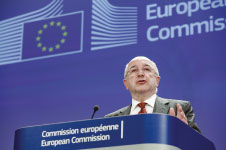
As essential public transport infrastructure, airports also play a crucial role in the communities they serve, be they big or small. It is only reasonable that local and national government are allowed to provide some support to airports, in order to safeguard the major economic and social benefits which these airports deliver.
The issue of State Aid is a major one within the European Union, but nowhere is it more contentious than within the aviation sector.
Open and fair competition is a cornerstone of the EU and the Treaty which underpins it. This means that economic market forces alone should dictate the success or failure of any activities considered as ‘economic activities’. Member State governments cannot in principle give unfair advantages to such businesses, and in particular, public money cannot be provided, except under very specific circumstances. This issue is referred to as ‘State Aid’. None of this directly concerned airports, until a 2000 judgement by the European Court of Justice which decided that airports should be considered as such ‘economic activities’ and should therefore be submitted to the EU State Aid rules.

After having first established a Board-endorsed common position, ACI EUROPE has had numerous meetings with a range of EC officials and political leaders, including Commissioner Joaquín Almunia, who oversees the Directorate General for Competition, which is driving the new guidelines.
The nature of the airport industry made the application of these principles extremely complicated, for a number of reasons. First and foremost, public funding is an unavoidably necessary component of the industry. Primarily this is a consequence of the fact that airports below a certain size are generally structurally unprofitable. Indeed, in 2011, ACI EUROPE reports that 42.5% of Europe’s airports were loss making. However it is also a reflection of the fact that larger airport projects are often of such scale that it is not credible to expect them to be 100% financed by private resources alone. As essential public transport infrastructure, airports also play a crucial role in the communities they serve, be they big or small. It is only reasonable that local and national government are allowed to provide some support to airports, in order to safeguard the major economic and social benefits which these airports deliver. Finally, since distortions of competition within the airline industry should be avoided, any possible transfer of public funds to airlines via publically-owned airports could also come under EU scrutiny. Yet at the same time both publically and privately-owned airports are in a competitive landscape, and need the commercial freedom to be able to offer credible deals to their current and prospective airline customers.
The resulting complications led to a situation which to date has been extremely unclear. The European Commission (EC) published guidelines in 2005 specifically to give guidance as to in what circumstances it would or would not consider public funding of the aviation sector to be acceptable. However a lack of enforcement and the further evolution of the industry meant that greater clarity always remained out of reach.

The proposal to limit operating aid only to airports with less than 200,000 passengers per annum is particularly damaging. This is all the more so since the draft guidelines themselves acknowledge that airports below 1mppa cannot be expected to cover such costs.
What lies beneath
The EC is about to produce new guidelines to replace the 2005 text. While the provision of greater clarity is a key component of the initiative, it is not the only driver. The continued rise of the low-cost carrier (LCC) business model, and the extreme competitive pressures which this has placed upon smaller airports in particular, has led to a number of high profile legal cases where the EC has objected to arrangements between these LCCs and airports. Alongside this, the recent dominance of the politics of austerity dictates that public funding should be sharply reduced, and restrictions on the funding of airports is seen as a very visible means of achieving this. These have combined to create a new political orthodoxy that there are ‘too many small airports in Europe’. As a result, the new EC guidelines look set to be extremely restrictive, in terms of what public funding of airports will be considered acceptable.
With proposed new guidelines to be published early June, the latest available information indicates that only a very limited scope of public support to airports will be permitted, beyond which any measures will have to undergo rigorous scrutiny by the EC. Of particular concern are the proposals concerning funding of day-to-day airport operations. After a transitional period of 10 years, only airports with less than 200,000 passengers per annum could be entitled to such operating aid.
The financing of infrastructure is a key challenge for many regional airports. Yet support for investments at airports will only be allowed at airports below 5mppa. Within this threshold, the allowed intensity of aid will reduce as airports get larger, and there is also the possibility that any investment aid to airports above 3mppa will have to be repaid with interest, although this has yet to be confirmed.
New limitations may be imposed upon start-up aid for airlines, although this also has yet to be confirmed. As well as being only possible within a transitional period, only airports with less than 3mppa will be entitled to provide start-up aid to airlines. It cannot be paid for more than 2 years, and such aid might only cover up to 50% of allowable start-up costs.
What does it all mean for airports?
While the details of the new guidelines will impact different airports in very different ways, the aggregate impact on the European airport industry will undoubtedly be harsh and negative. ACI EUROPE has estimated that new guidelines could force the closure of potentially up to 80 small regional airports across Europe. Many of these airports cannot credibly be expected to cover their capital costs, let alone their operating costs – the market simply would not bear the level of airport charges which would be required to cover the considerable fixed costs inherent to the running of these airports. In this context the proposal to limit operating aid only to airports with less than 200,000 passengers per annum is particularly damaging. This is all the more so since the draft guidelines themselves acknowledge that airports below 1mppa cannot be expected to cover such costs.
At the other end of the market, the full preclusion of public support for large airport projects would put Europe at a major competitive disadvantage, in particular relative to emerging economies, where aviation is being recognised as a strategically important industry, and massive volumes of public money are being pumped into the necessary supporting infrastructure. A case in point is the potential new gateway airport for London – a recent report by economic consultants Oxera found that a new hub airport would not be commercially viable as a purely private-sector venture.
In light of the potentially devastating impact on airports and their communities, ACI EUROPE has been particularly active in this area over the last year. After having first established a Board-endorsed common position, ACI EUROPE has had numerous meetings with a range of EC officials and political leaders, across a number of relevant Directorate Generals (departments within the EC). This included Commissioner Joaquín Almunia, who is in charge of the Competition portfolio within the EC and thus oversees the Directorate General for Competition, which is driving the new guidelines. ACI EUROPE has also worked to drive the debate, performing economic analysis to inform the EC’s deliberations, and publishing a paper on the importance of regional airports in Europe. Alongside this ACI EUROPE is also reaching out to wider stakeholders, presenting at an Economic & Social Committee hearing on the issue and partnering with the Assembly of European Regions – the largest independent network of regional authorities in wider Europe. As part of these efforts, ACI EUROPE will also present at a special European Parliament hearing on the issue on 10 July in Brussels, organised in partnership with the French airport association – UAF.
The next phase: An opportunity for local, regional & national governments
While much work has been put into the issue to date, more can still be done to ensure that the airport perspective is better reflected in the guidelines. In particular the publication of the guidelines will be accompanied by a public consultation during the summer. While ACI EUROPE will be making a comprehensive input to this consultation, it also represents a very important opportunity for the EC to hear directly from regional airports which are most likely to be hit by these policy changes. Equally, if not more importantly, it is a chance for local, regional and national governments to make clear that these guidelines will have a seriously detrimental impact on the health of those economies and communities which depend upon air connectivity to remain vibrant. Therefore airports who are potentially at risk should work closely with their local, regional and national authorities, to send a strong and unified response to the upcoming consultation.







